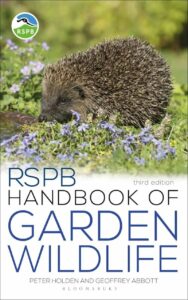 Now in its third edition, the RSPB Handbook of Garden Wildlife is a comprehensive and inspiring guide to making the most of your garden for wildlife. Full of practical tips, the book provides information on what plants to grow and how to structure your outside space to make it as attractive as possible for garden species, including mammals, birds, insects, invertebrates, reptiles and amphibians. A DIY chapter includes lots of projects such as nest box building and making your own pond.
Now in its third edition, the RSPB Handbook of Garden Wildlife is a comprehensive and inspiring guide to making the most of your garden for wildlife. Full of practical tips, the book provides information on what plants to grow and how to structure your outside space to make it as attractive as possible for garden species, including mammals, birds, insects, invertebrates, reptiles and amphibians. A DIY chapter includes lots of projects such as nest box building and making your own pond.
There is also a comprehensive species account section which includes information and colour photographs of almost 400 garden species, helping you to take stock of the wildlife that is present in your garden, and to monitor how this changes over time. The third edition of the RSPB Handbook of Garden Wildlife also features new material on climate change, recycling and encouraging wild spaces in gardens.

Peter Holden is the author of the bestselling RSPB Handbook of British Birds. He held senior positions at the RSPB for over 30 years and is the author of several books. Geoffrey Abbott formerly worked for the RSPB and now lectures part-time for the Field Studies Council. He is responsible for the book’s plants and insects sections.

In this Q&A we chatted with Peter and Geoffrey about the book, about the importance and benefits of keeping our gardens ‘wild’ and their recommendations for small but impactful changes we can make in our outdoor spaces.
Now in its third edition, it has been 14 years since the first Handbook of Garden Wildlife was published. Do you think there have been significant changes in terms of types/styles of gardens and the wildlife they support during this time?
Geoffrey: there is now even more pressure on natural habitats and wildlife, and a continuing decline in many species such as bees, Starling and House Sparrow. This means that gardens are of even more value for conservation. At the same time there are more new houses, with smaller, or no gardens, and a continuing trend (as David Lindo so graphically points out in his foreword) to cover gardens with concrete or paving. There are also changes in our gardens due to the arrival of new species, some perhaps due to climate change. We have included some of the species (like Ivy Bee and Tree Bumblebee) that you are most likely to see in your garden.
Peter: Gardens will also be affected by changes in climate, especially if we have drier summers so we have introduced a new chapter on dry gardens.
In the book, you recommend keeping a log of the wildlife observed in a garden over the year. Do you think that this has become something of a lost art – taking the time and having the patience to observe the same bit of land over time and enjoying the process of noting the changes?
Peter: Yes, I see fewer people using a notebook and pencil when out birding and they don’t seem to be recording on mobiles either, even though there are excellent Apps like the BTO’s Birdnet. It should be easier than ever to keep notes at home using electronic spreadsheets and diaries. With programmes such as iRecord you can input photos and sightings and have the satisfaction of knowing these records are added to local and national databases – helping to build up a picture of changing wildlife populations.
In the introduction, you mention how important our gardens became to us during the Covid-19 lockdowns of 2020 and 2021. Improving them for the local wildlife has obvious benefits for conservation, but do you think there are also benefits from making these changes for ourselves and for our children?
Peter: There is more and more evidence showing environmental benefits on wellbeing and general health. There are also the additional benefits of exercise that comes from gardening and opportunities for relaxation. However, best of all, I see gardens being the ideal place for small children to start to learn about nature. It might be watching an ant’s trail, planting wildflowers, feeding the birds or helping to prepare a small pond, making pitfall traps for bugs or doing the Big Garden Birdwatch. And it’s not just parents – grandparents are often the ideal teachers for the next generation – with more time to share their own knowledge and experience.
In the section of your book on wilding, you describe the ideal garden as ‘organised chaos’. Do you think that the current trend for neatness and tidiness in a garden can be problematic in terms of attracting wildlife?
Geoffrey: Absolutely. Just one example is clearing all the dead heads from the borders which removes important food sources in the form of seeds, for birds and small mammals. Hollow dead stalks are also important sites for many hibernating insects. Tidying beds of leaf litter removes a whole community of invertebrates, and important feeding sites for thrushes, Blackbirds and Robins. Colonies of House Sparrows love scruffy corners and dense shrubs, while a pile of prunings and dead leaves can even provide a hibernation site for hedgehogs and a home for beetles and other invertebrates. Converting part of the garden to concrete or paving, or even replacing a lawn with Astroturf for easier management, will make whole areas sterile of wildlife.
One part of the book that I found particularly useful was the section on seasonal management, which also includes a handy monthly guide to the wildlife you might see and the tasks that need to be undertaken. How much would you say that maintaining a garden for wildlife differs from more ‘conventional’ gardening techniques?
Peter: That is an interesting question as there is not really a right or wrong way of doing things. It’s really about empathy – understanding your garden environment and gradually moving it from a homocentric place to one where wildlife is the focus. Every action will have nature in mind, while still keeping the garden as our own special place – it’s a delicate balance…and its fun…and over time our knowledge will grow as well.
For any readers with an average sized urban or suburban garden who wants a quick and affordable change that they can make, what would you recommend as something impactful but achievable that they could begin with?
We are both agreed that by far the best single improvement is to create a pond.
Geoffrey: This will greatly encourage garden wildlife by providing a source of water (for animals such as bees, birds and hedgehogs), mud for nesting birds, and a variety of extra insects as food. The pond will also add a whole new community of creatures, many of which leave the water at the adult stage. You may encourage frogs, toads or newts, as well as insects such as dragonflies and damselflies. These can give a whole new dimension to the summer garden.
Peter: A pond need not be large or complicated to make. A simple moulded plastic or flexible liner will suffice. It needs to be deep enough not to dry out but have some shelving edges to allow birds or hedgehogs to drink. However, avoid introducing fish – they are incompatible with most other wildlife in a garden pond.
Finally, what are you working on now? Do you have plans for further books?
Geoffrey: I will be writing wildlife notes for local magazines.
Peter: I will continue to work on updates for future editions of this Handbook and also for the RSPB Handbook of British Birds. I will continue with lectures for RSPB local members’ groups and hope to meet some of you there!
RSPB Handbook of Garden Garden Wildlife by Peter Holden and Geoffrey Abbott was published in February 2023. It is published by Bloomsbury Publishing and available from nhbs.com.








